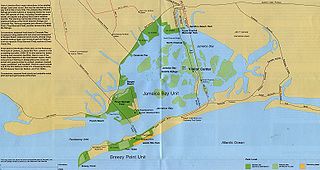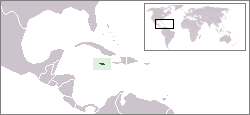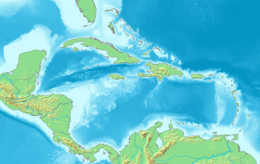
Jamaica is an island country situated in the Caribbean Sea. Spanning 10,990 square kilometres (4,240 sq mi) in area, it is the third largest island — after Cuba and Hispaniola — of the Greater Antilles and the Caribbean. Jamaica lies about 145 km (90 mi) south of Cuba, and 191 km (119 mi) west of Hispaniola ; the British Overseas Territory of the Cayman Islands lies some 215 km (134 mi) to the north-west.

Kingston is the capital and largest city of Jamaica, located on the southeastern coast of the island. It faces a natural harbour protected by the Palisadoes, a long sand spit which connects the town of Port Royal and the Norman Manley International Airport to the rest of the island. Kingston is the largest predominantly English-speaking city in the Caribbean.

Jamaica Bay is an estuary on the southern portion of the western tip of Long Island, in the U.S. state of New York. The estuary is partially man-made, and partially natural. The bay connects with Lower New York Bay to the west, through Rockaway Inlet, and is the westernmost of the coastal lagoons on the south shore of Long Island. Politically, it is primarily divided between the boroughs of Brooklyn and Queens in New York City, with a small part touching Nassau County.

Saint Mary is a parish located in the northeast section of Jamaica. With a population of 114,227 it is one of Jamaica's smallest parishes, located in the county of Middlesex. Its chief town and capital is Port Maria, located on the coast. It is also the birthplace of established dancehall reggae artists, such as Capleton, Lady Saw, Ninjaman, Sizzla, and Tanya Stephens. Other notable residents of St. Mary parish include bestselling author Colin Simpson, who is the great-great grandson of noted slavery abolitionist James Phillippo, famed Jamaican writer and community activist Erna Brodber, and acclaimed music producer Chris Blackwell who is credited with "discovering" Bob Marley.

Saint Elizabeth, one of Jamaica's largest parishes, is located in the southwest of the island, in the county of Cornwall. Its capital, Black River, is located at the mouth of the Black River, the widest on the island.
Ralston Milton "Rex" Nettleford, OM, FIJ, OCC, was a Jamaican scholar, social critic, choreographer, and Vice-Chancellor Emeritus of the University of the West Indies (UWI), the leading research university in the Commonwealth Caribbean.
Pedro Bank is a large bank of sand and coral, partially covered with seagrass, about 80 km south and southwest of Jamaica, rising steeply from a seabed of 800 metres depth. It slopes gently from the Pedro Cays to the west and north with depths from 13 to 30 metres. The total area of the bank within the 100-metre (328-foot) isobath measures 8,040 square kilometres. The area of a depth to 40 metres is triangular, 70 kilometres long east-west, and 43 kilometres wide. 2,400 square kilometres are less than 20 metres deep. With its islets, cays and rocks, a total land area of 270,000 m2 (2,906,256 sq ft), it is the location of one of the two offshore island groups of Jamaica, the other one being the Morant Cays. The bank is centered at 17°06′N78°20′W.
The Jamaican Caves Organisation (JCO) is an all-volunteer caving organisation devoted to the preservation, exploration and documentation of caves in Jamaica. It is currently the only non-profit group in Jamaica dedicated to education, research and advocacy about caves.

Vincent "Ivanhoe" Martin, known as "Rhyging", was a Jamaican criminal who became a legendary outlaw and folk hero, often regarded as the "original rude boy". He became notorious in 1948 after escaping from prison, going on the run and committing a string of robberies, murders and attempted murders before he was gunned down by police. In subsequent decades his life became mythologised in Jamaican popular culture, culminating in the 1972 cult film The Harder They Come, in which he is portrayed by Jimmy Cliff.

The following is an alphabetical list of topics related to the nation of Jamaica.

Jon Baker (born 1960) is a music industry executive. He has worked as a fashion designer, promoter, and is currently co-owner of Geejam, a luxury resort and recording studio located in San San, near Port Antonio, Jamaica.
Little Goat Island along with Great Goat Island are the cays that make up the Goat Islands, located less than a mile off the coast of Jamaica, southwest of the Hellshire Hills. It is part of Saint Catherine Parish. Little Goat Island is adjacent to the northwest portion of Great Goat Island, and both are within the Portland Bight Protected Area.
The Portland Bight Protected Area (PBPA) was created by the Jamaican government in 1999 to protect a large marine and terrestrial area on the island of Jamaica located southwest of Kingston. Nearby cays such as Little Goat Island are included. It is the largest protected area in Jamaica and comprises 724 square miles (1,880 km2). Although the first priority in forming the protected area was to protect the coral reefs, it also serves to protect vulnerable and endemic species. The PBPA includes 32 square miles (83 km2) of wetlands on the island, and coastlines of mangroves, as well as sea-grass beds that serve as a nursery for fish and shellfish breeding. The Caribbean Coastal Area Management Foundation (C-CAM) has been charged with managing zones within the protected area.
The Jamaican Fire Brigade operates several fireboats of Jamaica. According to a 2003 article in the Jamaica Gleaner the three fireboats then nominally operated by the Fire Brigade were all in a state of disrepair, and had all been out of service for months—or in the case of one vessel—years. According to another Gleaner article the stations were dangerously over-run with rats and other vermin.

Adam Stewart is a Jamaican businessman. He is the Executive Chairman of the Caribbean-based resort company Sandals Resorts International (SRI) and Beaches Resorts, President of the Sandals Foundation, the philanthropic arm of Sandals Resorts International and Executive Chairman of the ATL Group, a Jamaica-based automotive, commercial, and domestic appliance distributor.

The fauna of the United States Virgin Islands consists of 144 species of birds, 22 species of mammals, 302 species of fish and 7 species of amphibians. The wildlife of the U.S.V.I. includes numerous endemic species of tropical birds, fish, and land reptiles as well as sea mammals. The only endemic land mammals are six species of native bats: the greater bulldog bat, Antillean fruit-eating bat, red fruit bat, Brazilian free-tailed bat, velvety free-tailed bat and the Jamaican fruit bat. Some of the nonnative land mammals roaming the islands are the white-tailed deer, small Asian mongoose, goats, feral donkeys, rats, mice, sheep, hogs, dogs and cats.
Hellshire Hills is a region of dry limestone hills in St Catherine Parish, Jamaica, which forms part of the Portland Bight Protected Area. The region supports one of the largest remaining areas of dry limestone forest in the Caribbean, and supports endangered Jamaican endemics include the Jamaican iguana and the blue-tailed galliwasp.











